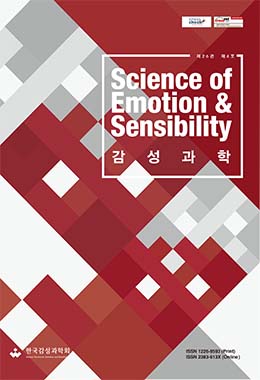최근 소셜미디어 이용이 심리적 웰빙에 미치는 영향이 부각되고 있으나 어떤 요소가 소셜미디어 상에서의 관계의 질을 예측할 수 있는지에 대한 연구는 상대적으로 드물다. 본 연구는 머신러닝 기법을 이용하여 COVID-19로 인한 자가격리 동안 인스타그램 활동과 외로움, 우울 등의 심리 상태가 소셜미디어 상에서의 관계의 질을 예측할수 있는지 알아보고자 하였다. 성인 95명을 대상으로 자가격리 중과 자가격리 해제 후 시점에서 외로움, 인스타그램 활동, 소셜미디어 상에서의 관계, 우울 등에 대해 자기보고식 설문에 응답하도록 하였다. 그 후, 다차원 척도법과 표상유사성분석, 분류분석을 각 시점에 대해 수행하였다. 다차원척도법 결과, 1차원에서 인스타그램 이용 시간과 우울이 다른 변인들과 구별되었으며, 2차원에서 외로움과 수동적 이용이 다른 변인들과 구별되었다. 그 후 소셜미디어 상에서의 관계의 질의 고,저 집단에 대해 표상유사성분석을 실시한 결과, 소셜미디어 상에서의 관계의 질이 높은 집단은 낮은 집단보다 자가격리의 영향을 더 많이 받는 것으로 나타났다. 분류분석 결과에서도 소셜미디어상에서의 관계의 질 예측 변인이 사회적 고립의 여부에 따라 달라지는 것으로 나타났다. 따라서 본 연구의 결과는 사람들이 사회적 고립 상황에 있지 않을 때 인스타그램 이용 변인과 심리적 변인이 소셜미디어 상에서의 관계를 더 잘 예측할 수 있음을 시사한다.
Recently, the effect of using social media on psychological well-being has been highlighted. However, studies exploring factors that may predict the quality of social media relationships are relatively rare. The present study investigated whether social media activity and psychological states, such as loneliness and depression, can predict the quality of social media relationships during the COVID-19 quarantine period using a machine learning technique. Ninety-five participants completed a self-report survey on loneliness, Instagram activity, quality of social media relationships, and depression at different time points (during the self-isolation and after the release of self-isolation). Similarity analyses, including multidimensional scaling (MDS), representational similarity analysis (RSA), and classification analyses, were conducted separately at each point in time. The results of MDS revealed that time spent on social media and depression were distinguished from others in the first dimension, and loneliness and passive use were distinguished from others in the second dimension. We divided the data into two groups based on the quality of social media relationships (high and low), and we conducted RSA on each group. Findings indicated an interaction between the quality of the social media relationships and the situation. Specifically, the effect of self-isolation on the high-quality social media relationship group is more pronounced than that on the low-quality group. The classification results also revealed that the predictors of social media relationships depend on whether or not they are isolated. Overall, the results of this study imply that social media relationship could be well predicted when people are not in isolated situations.


